While Time Spent Listening is dropping in many European radio markets, Belgium does a great job and is also able to reach younger audiences very well. Here’s how.
Public broadcaster VRT in Flanders doesn’t have just one youth station. Instead, they serve distinctive types of young listeners through separate, multi-platform channels. Els van de Sijpe, VRT Mediamanager Radio, explained all ins & outs during the Atelier Radiophonique Romand 2013 in the Swiss city of Neuchâtel. “We are building 360° brands”.
“I made one mistake – I started at television”
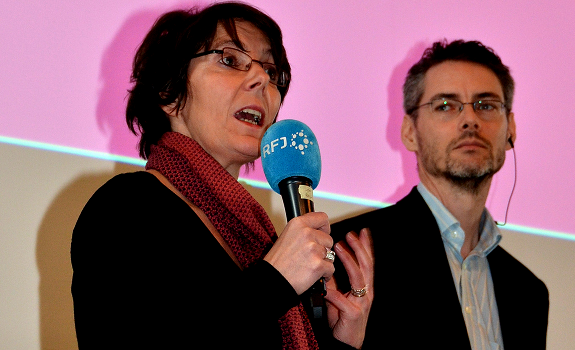
VRT Mediamanager Radio Els van de Sijpe (here on stage with radio futurologist James Cridland) discovered her passion for radio when working as a reporter and is involved in Belgian radio for 2 decades now (photo: ARARO)
5 VRT radio stations
“I made one mistake – I started at television”, she jokes about her early career days. Soon after, Van de Sijpe fell in love with radio. From 1993 she was a reporter, senior editor and coordinator at VRT family station Radio 2. In 2007 she became program director of news-oriented Radio 1, where she headed a relaunch. Three years after, the Flemish public broadcaster made her responsible for the entire radio portfolio. The CIM ratings book 2012-III shows that the 5 main VRT radio channels have a collective market share of 62% and a daily reach of 3,5 million listeners in this area of over 6 million people:
• Radio 1: News, Talk and Sports (8%)
• Radio 2: Full Service AC (28%)
• Klara: Classical / Cultural (2%)
• MNM: CHR (11%)
• Studio Brussel: Alternative CHR (13%)
Belgium: a small country, where radio is big!
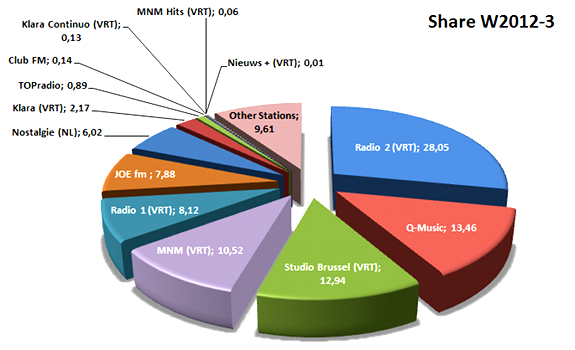
Belgium has an interesting radio market: they not only have the second largest TSL in Europe, but also stand out in another way. The Flemish public broadcaster VRT ‘owns’ close to 2/3rd of this entire radio market (chart: CIM)
3 VRT radio competitors
That leaves just a bit more than 1/3rd of the pie for other radio stations in Flanders. Like most countries in Europe, Belgium differentiates between public (government-funded) and private (company-owned) broadcasters. The 3 largest commercial competitors of the VRT radio stations are:
• Q-music: Hot AC (13%)
• JOE fm: AC (8%)
• Nostalgie: Oldie-based AC (6%)
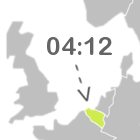 Belgian people listen long
Belgian people listen long
Belgium: a small country, where radio is big! A whopping 4 hours and 12 minutes a day (source: EBU Guides, 2012) makes that the divided country is second in Europe in terms of Time Spent Listening. “Partly due to the very high position of Radio 2”, Els van de Sijpe clarifies. Radio is the second most popular medium in Belgium – 1/4th of people’s media consumption time is spent on radio (source: TNS Media Brand Media Monitor, 2008-2010).
Belgian radio reaches 90%
The CIM ratings book 2012-II shows that radio in Belgium has a weekly reach between 88% and 90% of all media consumers between the age of 12 and 54. To make the market picture complete:
• In terms of daily reach, we see a bigger difference when we compare the reach of a wide demographic with the numbers for a younger audience. Belgian radio stations collectively reach 75% of the 18-54 year-old audience demographic, but ‘just’ 68% of all 12-24 year-old radio listeners a day – that’s still over 2/3rd of all young people. The listening time among young listeners decreases in many countries, but remains relatively stable in Belgium.
• Other positive news for the Belgian radio industry is that it’s growing financially. 2012 showed a 10% increase of radio’s piece of the advertising pie, compared to the previous year. In Belgium, about 13% of all annual ad spends are being invested in radio commercials – making radio the third medium in the country, after TV and newspapers (source: MDB National, 2012).
Tech savvy, digital natives

Today’s young radio audience has of course grown up with smart phones, Internet, Facebook, Twitter & YouTube – they know how to use new media, digital devices and mobile apps like no one else (photo: Public Domain Pictures)
Young people: common grounds
“It’s important for a public broadcaster to reach young people, because they are the listeners of tomorrow”, Van de Sijpe knows. To develop a strategy to reach young people, VRT did research to look at both what they have in common and how they are different. Here are some things that almost all young people in Belgium (and around the world?) share to begin with:
• Social pressure: they feel constantly judged and obliged to be successful at school or at work
• Internal pressure: they want to find ‘their thing’ to be the best at, but find it hard to find their way in a serious and demanding world
• Modest dreams: they are children of a crisis with unemployment among young people, creating fear and concerns about the future and quite modest dreams
• Digital natives: they are tech savvy and digital natives; they’re used to smart phones, and know their way on the Internet and social media
• Scarce friends: they have numerous friends on Facebook, however: real and close friends are scarce
• Escape desires: sports and creative hobbies are their favorite way to escape from the pressure
• Fun addiction: they are very passionate about music, and they love fun & entertainment
Young people are becoming eclectic
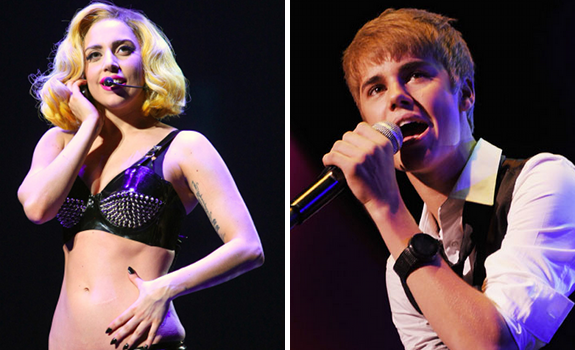
As young music consumers like a variety of individual songs, and are less into specific artists or genres, most of the fame goes to a few mass-appeal pop icons, e.g. Lady Gaga and Justin Bieber (photos: Starcasm / The Bert Show)
Young generation and music
Based on a PPM enumeration, VRT has found that nearly 80% of all 12 to 24-year-olds in Flanders consider music to be ‘very important’ or at least ‘important’. But it becomes clear that young people consume music in a totally different way than former generations:
• Songs have a shorter lifetime: today’s youth doesn’t have record collections or CD piles in their room, but MP3 files on their computers [and mobile devices] instead, which makes music ephemeral and volatile instead of tangible and permanent
• Young listeners are song oriented: young people don’t buy full CDs [or download complete albums] anymore to discover new music, not even from their favorite artists; they look around online on YouTube or iTunes instead, and download individual songs
• Young audiences are becoming eclectic: instead of being totally into one defined genre or just one single artist, young audiences like certain songs [again, song oriented] from different genres and artists – consequently, only a few idols get all fame
 Young people and fun
Young people and fun
Young people need a good laugh; they feel like the world is serious enough already. Apart from humor they like to play and fool around. That’s more than playing video games – outdoor activities matter just as much, and they love excitement. Young audiences not only look for kicks and extremes, but also for some inspiration and stimulation. And at the end of the day, they want to get piece of mind and relax from their busy lifestyle.
Young generation and media
The same research (conducted by interviewing members of the VRT Portable People Meter panel) shows that today’s generation expects different things from different media types:
• Internet: social, entertainment
• Television: chilled, relaxed, cozy – but also energy, adventure, obstinate
• Radio: light-hearted, enjoying life, creative, funny but social, interesting people, music
A more in-depth mapping study regarding motivations and expectations of young media consumers allowed VRT to develop a radio strategy to reach different groups of young people. “They all expect the fun layer of radio, but they differentiate in their surplus to the fun”, Els van de Sijpe says, explaining that people with a different social context and life phase also expect different things from a radio station, even if they have the exact same age. “A 20-year-old worker who comes home after a hard day’s work has other needs and expectations than a 20-year-old student who is looking for intellectual stimuli in his spare time.”
Ambitious & adventurous vs. relaxing & reassuring

Studio Brussel and MNM are each directed towards a different target audience and listener profile – covering the broad spectrum from the progressive left to the conservative right (photos: Andrew Holt / HD Wallpapers)
StuBru: ambitious & adventurous content
Studio Brussel (also abbreviated as StuBru, slogan: Life is Music) is the young and adventurous radio channel of the Flemish public broadcaster. Their mission statement says: ‘Studio Brussel encourages an active musical experience as the driving force of an adventurous and peculiar view of the world’. In other words: a progressive radio station, for forward-thinking people:
• They like freedom and progress, and are very ambitious
• They feel that they can make a real difference within the world
• They are looking for an affirmation of their own distinct identity
• They want to move forward and explore as much as possible
• They wish to grow and develop personally
StuBru is therefore dynamic; open to different ways of thinking and living. Self-expression and social interaction play an important role on this progressive station as well.
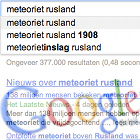 Listeners switch between media
Listeners switch between media
Studio Brussel has a very active audience, not only in terms of personal values and life goals; also in terms of how they consume media. StuBru listeners jump from one medium to another: “When they hear something on the radio that catches their interest, they will look it up on the Internet or start chatting about it on Facebook”, Els van de Sijpe knows. “So the content has to be omnipresent; it has to be on all platforms.”
MNM: relaxing & reassuring radio
MNM (an acronym of the positioning statement ‘Music and More’) is the youngest radio brand of Flemish public broadcaster VRT. Where its left-wing counterpart Studio Brussel is more based on a mindset rather than age, the state of mind of right-side MNM is being a join-in hit music station for a young audience demo of 12 to 24-year-olds. According to Van de Sijpe, more than a quarter of the listeners are under the age of 20 years. MNM aims to be ‘an approachable and young ‘inclusive’ station and a relaxing hit radio that focuses the attention on the listener and his social environment with a relevant informative offer’. Consequently, it’s a conservative radio station, for stability-seeking (young) people:
• They like security and control
• They are typically uncertain about their place in society and their future
• They want to fit in and be accepted rather than standing out from the crowd
• They are looking for peace and a safe environment (like family and sports clubs)
• They like to mentally escape and just relax without much intellectual effort or surprises
MNM therefore sounds very different than Studio Brussel – much more reassuring, straightforward, easy to digest. It’s basically a cozy welcoming channel that offers them an uncomplicated way of relaxation.
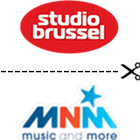 Communal view vs. individual perspective
Communal view vs. individual perspective
MNM is focusing on listener-sized news, social commitment and team spirit. Basically, it’s socio-driven; not ego-driven like Studio Brussel. MNM wants to be an interactive platform that respects every opinion. Both stations have a different music profile as well. Studio Brussel is more likely to explore Rock, Electronic and Alternative genres; MNM’s playlist is centered around Pop, Dance and Urban music styles.
Open endings vs. filled gaps
Both audience groups are processing information in a different way, so both radio stations are delivering news with a different approach. Simply put: Studio Brussel might raise questions; MNM always deliver answers. Journalists, reporters and presenters of StuBru can afford it to leave some questions open, thus stimulate the listener to think about it and form his/her own opinion. If their audience is interested, they’ll do their own research; even if it’s an unfamiliar topic. The team of MNM doesn’t leave questions unanswered; their listener wants to be reassured that he/she has the full picture. MNM is focusing on news that is part of the listener’s world, and is asking feedback from the community (using vox pops, for example).
From Marathon to #Mashtag
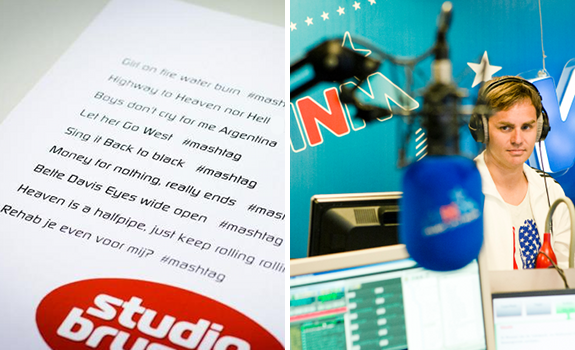
Along the lines of their unique stationality and specific audiences, the two young VRT stations run different kinds of station promotions – from Marathon Radio on MNM to #Mashtag on Studio Brussels (photos: VRT)
MNM radio promotion examples
Here are 3 examples of radio promotions that MNM has been doing recently:
• Start to DJ: a deejay contest during the station’s summer tour, where the winner not only got weekly airtime on MNM, but also became a support act of David Guetta
• De Strafste School: a contest between school communities in search of ‘the coolest school’ in Flanders in which more than 2/3rd of all secondary schools participated
• Marathon Radio: morning show host Peter van de Veire was on air for 185 consecutive hours, and he only slept for 8 hours during 8 days of this (almost) non-stop broadcast.
Marathon Radio was done in the middle of a high school exam period, thus supporting students and giving them a fun companion. Els van de Sijpe: “There are 6 million people in Flanders and more than 2 million people tuned into the show at one moment or another. Young students felt united and we encouraged them to come through the difficult and stressful exam period.”
“This sounds a bit crazy”
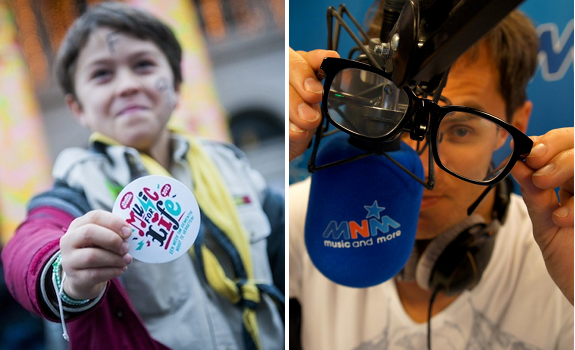
Studio Brussels didn’t use Music for Life 2012 to raise funds, but to raise knowledge about dementia – so trying to put this ‘older people’s desease’ on the agenda of a young generation was a bit risky (photos: Cutting Edge / VRT)
StuBru radio promotion examples
These are 2 examples of radio promotions on Studio Brussel over the last months:
• #Mashtag: when Studio Brussel reached 100.000 Twitter followers, they did a contest to find ‘the ultimate follower’ of the station. All followers could send in their song music mashups (using the hashtag #mashtag, which was trending on Twitter soon after). The winner is now able to also physically follow the station everywhere it goes (by getting free tickets for the station’s events or supported festivals).
• Music For Life: an adaption of 3FM Serious Request, a fundraising radio marathon in the week before Christmas in which 3 deejays are making radio 24/7 from a glass studio in the middle of a big city, without being allowed to eat any food during the entire time – however, goal of the 2012 edition was no to raise money, but to raise awareness for the growing problem of dementia.
“This sounds a bit crazy; how do you involve young people in such a serious topic?”, Els van de Sijpe realizes, as dementia is not a subject that concerns the younger generations. They decided to do did it anyway, as “it was corresponding with the values of Studio Brussel” and along the station’s nature to experiment and explore.
 Building 360° multi-platform brands
Building 360° multi-platform brands
The VRT radio director points out that “we have to be where our audience is” and says it’s key to create a multi-platform brand around your radio station. Studio Brussel is very active in social media (250.000+ fans on Facebook and 100.000+ followers on Twitter as of January 2013) and young station MNM is producing some of its content exclusively for its website audience. “We are not making radio stations. We are building 360° brands.”
Software as new hardware
To keep in touch with a young audience, the Flemish public broadcaster is also investing in new technology. “Software is the new hardware; enriching the radio experience and strengthening the relation with the target group”, Van de Sijpe knows. “We have a new radio player with more visuals – because radio is becoming more and more visual – and lots of interactivity.” The publicly available beta version of this Radio+ player will be improved with input from the user community. Listeners can send in their ideas for additional features. A future upgrade will probably include the option to scroll back in time, allowing you to go back to the beginning of an interview of which you’ve missed the first minutes.
“Radio is a bit like your dog”
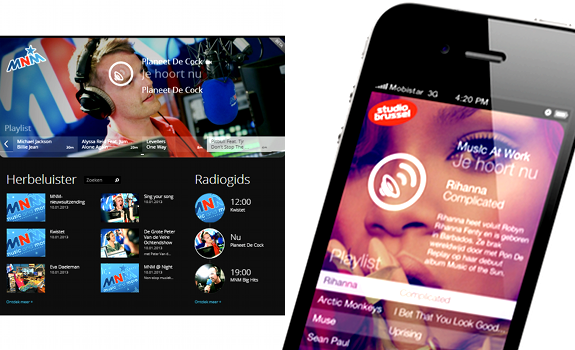
Radio will always remain to be a friendly companion for news, entertainment and music – only the way that radio content is reaching consumers is evolving. On the left: the beta version of Radio+, the Flemish public broadcaster’s new visual & social radio player (in the version for MNM). On the right: Studio Brussel’s iPhone app (images: VRT)
VRT radio focus points
These are 3 things that VRT radio is focusing on right now:
• Multiplatform radio: be where (young) listeners are with content that matters to them at that moment, and create a 360° multi-platform brand around your radio station
• Guide function: in a world in which we are confronted with an overload of news and information, radio can be people’s guide for discovering news and music
• Team events: spark new inspiration and fresh creativity within your radio team by organizing an annual (internal) radio event, like VRT’s Wild Radio conference
 Radio as friend & companion
Radio as friend & companion
Els van de Sijpe says that despite all technical innovation, radio’s basics still apply. “Like one of my bosses once told me: radio is a bit like your dog. He is barking when necessary. Not too much, because when he is doing that, it gets irritating and annoying. He’s always there. He’s your friend; your companion; keeping you informed whenever necessary. But also offering entertainment and music with not too much bla-bla.”





Add Your Comment